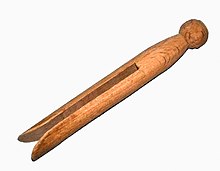Clothespin
After World War I, cheap imports from Europe began to flood the market, leading to repeated calls for protective tariffs by Vermont, and the state industry went into decline; in 1920, it cost 58 cents to manufacture one gross of clothespins in Vermont, while imported Swedish clothespins were sold for 48 cents a gross.
The situation worsened after World War II, and the introduction of the electric clothes dryer diminished demand for clothespins, further damaging the industry; the U.S.C.
However, the National Clothespin Company, who had previously moved from its original location across the street, and had been sold to a new owner, managed to stay in business by virtue of a contract with the F. W. Woolworths department store chain.
The profit margin was eaten into further by the increasing volume of cheap Chinese imports; pleas for protective tariffs continued, but to no result.
[6] During the production of a movie, commercial, music video etc., a spring-type clothespin is called a "CP 47", "C47", "47", "peg", "ammo", or "bullet".
[8] The wooden clothespins do not transmit heat very effectively, and therefore are safe to touch, even when attached to hot lights for a significant period of time.
People like gaffers, grips, electricians, and production assistants may keep a collection of C47s clipped to clothing or utility belt at all times.
The common, spring-loaded two-piece wood clothespin - marked in some manner with text and/or color-coding for the designated frequency it references, usually with an added piece of thin plywood or plastic on the clothespin to place the text or color-code upon for greater visibility - is the usual basis for these, whether the model club itself provides them already clipped onto a "frequency control board" for the modeler to take for their activity (clipped onto their transmitter's antenna, in a so-called "subtractive" method) or the modeler make them for their own transmitter(s), and places them on a club facility's existing frequency board (the "additive" method).
[13] For many years players in ensembles such as brass bands playing outdoors have used spring pegs to hold their music in place since even the mildest breeze will blow a loose sheet away.







